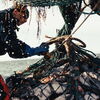More questions raised about proposed European lobster ban
 Courtesy / Tom Thai, Flickr
A ban of live North American lobster imports could amount to a $10.6 million loss to Maine's lobster industry, a ban that some industry leaders and lawmakers in the U.S. are calling an overreaction.
Courtesy / Tom Thai, Flickr
A ban of live North American lobster imports could amount to a $10.6 million loss to Maine's lobster industry, a ban that some industry leaders and lawmakers in the U.S. are calling an overreaction.
The plot thickens about the proposed European ban importing live American lobsters, with seafood export specialists joining Maine’s congressional delegation in raising questions about the science behind the labeling of the crustacean as an invasive species — a move that could cost Maine lobstermen millions.
Gavin Gibbons, a spokesman for the Virginia-based nonprofit National Fisheries Institute, told the Portland Press Herald that the proposed ban by Swedish officials could serve as a way for European countries to protect the market share of its native lobsters while avoiding “retaliatory tariffs” that might otherwise be added on exports of European seafood to North America if the ban were to be implemented.
Robert Bayer, executive director of the University of Maine’s Lobster Institute, also raised questions about the claims by Swedish officials that the ban is based around protecting native lobster species from a trio of diseases: epizootic shell disease, gaffkemia or “red-tail” and white spot syndrome.
Bayer told the Press Herald that epizootic shell disease, which is a bacterial infection that could be fatal to the crustaceans, isn’t contagious even under controlled environments.
The bacteria-caused infectious disease gaffkemia hasn’t been seen in a decade in the American lobster population, he added. “I haven’t seen that for about 10 years, so it’s gone,” Bayer told the Press Herald.
Finally, the highly lethal and contagious viral infection white spot syndrome doesn’t affect lobsters and is only transmittable to shrimp, he said.
In March, U.S. Sens. Susan Collins and Angus King and U.S. Reps. Chellie Pingree and Bruce Poliquin penned letters to Secretary of State John Kerry, U.S. Trade Representative Michael Froman and National Oceanic and Atmospheric Administration Administrator Kathryn Sullivan, asking for their support in protesting the invasive species designation.
"We urge you to engage in immediate efforts to ensure the continuation of safe and responsible import of live Maine lobsters, consistent with the EU's World Trade Organization obligations," read the letter. "Since only a small number of Maine lobsters have been found in foreign waters, we believe regulators should take a more finely tuned approach before calling this an 'invasion.'”
The potential ban could cost lobster fishermen and exporters in the U.S. $150 million a year, including $10.6 million in the state of Maine alone.
Read more
Swedish officials push to label 'Maine lobsters' as invasive species
Congressional delegation pans Swedish lobster ban
Odds drop for an ‘extremely early’ start to Maine lobster season
Maine raises age for completion of lobster apprenticeship
LePage adds voice to opposition of EU lobster ban
Warming waters could bring early lobster price drop
Mercury contamination closes fishing in part of Penobscot Bay
Sweden doubles down on proposed lobster ban
Following EU decision, Swedish officials go solo on lobster concerns













Comments